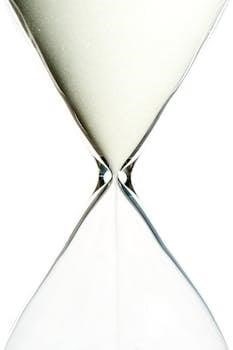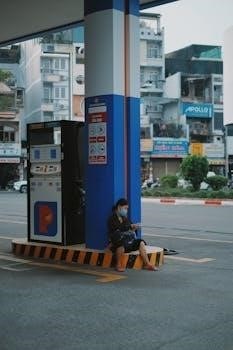
Waiting for Godot PDF⁚ An Article Plan
This article provides a structured exploration of Samuel Beckett’s Waiting for Godot, offering insights into its key aspects. It will delve into themes, characters, and the play’s unique structure. It also examines interpretations, its tragicomic nature and Beckett’s break from conventional theatre.
Waiting for Godot, a play by Samuel Beckett, stands as a landmark in 20th-century theatre, renowned for its innovative approach to drama. Originally written in French as “En attendant Godot,” it premiered in 1953, initially receiving mixed reviews. The play revolves around two central characters, Vladimir and Estragon, who are engaged in a seemingly endless wait for the enigmatic Godot, who never arrives. This simple premise forms the basis of a complex exploration of existential themes. Beckett’s work challenges traditional theatrical conventions, eschewing a linear plot and clear character development. The play’s setting is a desolate roadside, further emphasizing the sense of isolation and stagnation. Its blend of humor and despair, often labeled as tragicomedy, has intrigued and puzzled audiences for decades. Despite its initial reception, Waiting for Godot has become one of the most studied and interpreted plays, captivating readers and viewers with its profound themes and unique style. The play’s enduring popularity speaks to its ability to resonate with audiences across generations, making it a timeless work of literature.
The Absurdity and Futility of Waiting
At the heart of Waiting for Godot lies the profound exploration of the absurdity and futility of waiting. Vladimir and Estragon’s endless vigil for Godot, who never appears, embodies the human condition’s inherent meaninglessness. Their repetitive actions and conversations, coupled with the lack of progress, underscore the play’s central theme⁚ the pointlessness of striving for something that may not exist. The characters are trapped in a cycle of anticipation, a state of perpetual limbo where their hopes remain unfulfilled. This waiting becomes a metaphor for the human search for meaning in a world that often seems devoid of it. Beckett masterfully uses this absurd situation to reflect on the existential angst of humanity. The characters’ inability to leave, despite their desire, further emphasizes their entrapment in this futile cycle. This act of waiting, therefore, becomes a lens through which the audience examines the often-frustrating and directionless nature of human existence, highlighting the tragicomic nature of the search for purpose in a universe that may not offer any.
The Characters⁚ Vladimir and Estragon
Vladimir and Estragon, the two main characters in Waiting for Godot, are a study in contrasts, yet they are bound by their shared predicament of waiting. Vladimir, often referred to as Didi, is the more intellectual and rational of the pair, frequently attempting to make sense of their situation and cling to hope. Estragon, known as Gogo, is more impulsive and concerned with his immediate physical discomforts, like his aching feet. Their relationship is characterized by a mix of dependence and bickering, reflecting the complexities of human connection. They rely on each other for companionship in their desolate world, yet their interactions often descend into petty arguments. Despite their differences, both characters are fundamentally similar in their inability to escape their monotonous existence. They engage in philosophical and theological discussions, yet remain grounded in their mundane concerns. Their contrasting personalities and shared plight make them compelling figures that highlight the absurdity of human existence and the desperate search for meaning.
The Role of Pozzo and Lucky
Pozzo and Lucky’s entrance in Waiting for Godot introduces a dynamic of power and servitude that contrasts with Vladimir and Estragon’s static existence. Pozzo, the master, is a pompous and domineering figure, treating Lucky, his slave, as a mere object. Lucky, burdened with baggage and a rope around his neck, is subjected to Pozzo’s whims and commands. Their relationship highlights the themes of cruelty, exploitation, and the dehumanizing effects of power. Pozzo’s imperious pronouncements and Lucky’s subservience create a spectacle that entertains Vladimir and Estragon. However, this interaction also reveals the arbitrary nature of human relationships and the absurdity of social hierarchies. The dramatic shift in Pozzo and Lucky’s condition in Act II, where Pozzo becomes blind and Lucky is mute, further emphasizes the play’s exploration of change, decay, and the transient nature of human existence. The pair function as a distorted reflection of Vladimir and Estragon’s waiting, but they are actively engaged in a twisted form of action and interaction.
The Structure of the Play⁚ Repetition and Stagnation
Waiting for Godot is characterized by its cyclical structure, marked by repetition and stagnation. The two acts mirror each other, with similar events and conversations recurring. Vladimir and Estragon engage in the same routines, contemplating leaving but remaining rooted to the spot. The arrival and departure of Pozzo and Lucky, the boy’s message about Godot’s non-arrival, and the characters’ existential musings are all repeated with slight variations, emphasizing the futility and monotony of their situation. This repetitive structure reinforces the play’s themes of boredom, the passage of time, and the lack of progress. The characters’ inability to escape their cycle of waiting underscores their powerlessness and the absurdity of their existence. The play’s circular structure suggests that life is a series of repeated patterns, devoid of meaning or purpose, a constant anticipation of something that will never arrive, leading to a feeling of perpetual stagnation. This non-linear progression breaks from traditional theatrical norms.
Themes of Hope and Despair
Waiting for Godot intricately explores the interplay between hope and despair. The play revolves around Vladimir and Estragon’s persistent hope for Godot’s arrival, which they believe will provide meaning or salvation to their otherwise pointless existence. This hope, however, is constantly undermined by the repeated failures of Godot to appear, leading to a sense of profound despair. The characters grasp at any distraction or interaction to alleviate their boredom and hopelessness, be it through conversation, games, or the presence of Pozzo and Lucky. Yet, these distractions are fleeting and ultimately do not change their fundamental situation. The play questions the nature of hope itself, whether it is a genuine motivator or simply a delusion that perpetuates inaction. The cyclical structure of the play, with its constant repetition and lack of resolution, further contributes to a feeling of despair. The characters are trapped in a cycle of anticipation and disappointment. Despite their repeated despair, they continue to wait, highlighting the human capacity for both incredible hope and profound despair.

The Significance of Godot’s Absence
The absence of Godot is central to understanding the play. It is not merely a plot device but a powerful symbol that invites various interpretations. Godot’s non-appearance represents the futility of human endeavor and the absurdity of existence. The play questions the very nature of waiting and whether it’s a worthwhile activity. The characters are trapped in a cycle of anticipation, waiting for a promise that is never fulfilled. This endless waiting highlights the lack of purpose or meaning in their lives, and perhaps in human life in general. Godot himself can be seen as a representation of meaning, purpose, or even salvation, that is constantly deferred and unattainable. This deferred fulfillment leads to a sense of existential angst and a questioning of the human condition. The ambiguity surrounding Godot’s identity further adds to the play’s complexity, prompting the audience to consider their own search for meaning. Ultimately, Godot’s absence forces the audience and characters to confront the void and grapple with the inherent meaninglessness of the world. This absence is what drives the play’s narrative and its philosophical explorations.
Waiting for Godot as a Tragicomedy
Waiting for Godot masterfully blends elements of tragedy and comedy, creating a unique theatrical experience. The play’s comedic aspects arise from the characters’ absurd situations, slapstick humor, and repetitive dialogue. Vladimir and Estragon’s constant bickering and physical mishaps provide moments of levity, making their plight more palatable. However, beneath the surface of this humor lies a deep sense of tragedy. Their endless waiting, the lack of purpose in their lives, and the seemingly meaningless cycle of existence evoke a profound sense of despair. The characters’ inability to escape their predicament and their awareness of their own futility contribute to the tragic dimension of the play. The combination of these elements creates a poignant and unsettling effect on the audience. The play is not simply funny or sad; it is both simultaneously. This juxtaposition highlights the absurdity of human existence and the interplay between hope and despair. The tragicomic nature of the play forces the audience to confront the uncomfortable truths of life through the lens of both laughter and sorrow. This blend of genres is a critical element of the play’s overall impact.
Beckett’s Departure from Theatrical Conventions
Samuel Beckett’s Waiting for Godot is a radical departure from traditional theatrical conventions. Unlike conventional plays with clear plots, rising action, and resolutions, Godot presents a seemingly plotless scenario. The play’s structure is circular, with events repeating themselves rather than progressing. The characters, Vladimir and Estragon, are not typical protagonists; they lack clear motivations and are often passive, caught in a cycle of waiting. Beckett deliberately avoids providing a conventional sense of realism, emphasizing instead the absurdity of the human condition. The setting is vague and timeless, devoid of specific details, further contributing to the play’s sense of alienation. The dialogue is often fragmented, repetitive, and seemingly pointless, which challenges the notion of logical and coherent discourse typical in drama. The absence of a central conflict and any real climax subverts the audience’s expectations. Beckett’s use of silence and pauses is also unconventional, creating moments of discomfort and reflection. By abandoning these standard dramatic elements, Beckett forces the audience to confront the existential themes of the play and reflect on the very nature of theatre.

Interpretations and Analysis of the play

Waiting for Godot has invited numerous interpretations, reflecting its complex and ambiguous nature. One common reading is that the play represents the absurdity of human existence, depicting a world devoid of inherent meaning or purpose. The endless waiting for Godot, who never arrives, can be seen as a metaphor for humanity’s futile search for meaning and salvation. Some interpretations focus on the play’s existential themes, highlighting the characters’ struggle with boredom, isolation, and the fear of death. The characters’ repetitive actions and conversations are viewed as a commentary on the monotonous nature of modern life. The play’s lack of a clear resolution reinforces the idea that life is an ongoing cycle of waiting and anticipation, without any ultimate fulfillment. The relationship between Vladimir and Estragon is often analyzed as a representation of human interdependence and the need for companionship in the face of existential angst. The characters of Pozzo and Lucky are interpreted as symbols of power dynamics and the dehumanizing effects of servitude. Furthermore, the play’s comic elements, interspersed with moments of despair, contribute to its unique tragicalomic tone, inviting audiences to confront both the humor and the tragedy inherent in the human condition.
